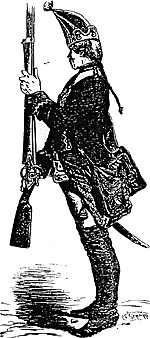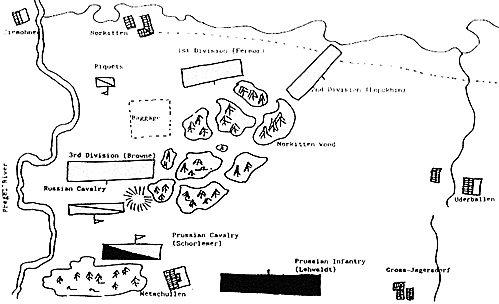 INTRODUCTION
INTRODUCTION
The overriding impression, at least amongst wargamers, of the Seven Years War, is of rather formulaic battles fought by rigidly disciplined troops at a predetermined location and time Gross-Jagersdorf represents quite a different phenomenon. The hapless, slumbering Russians were caught on the hop and set upon in the early hours of the morning by the most feared soldier in Europe. Despite apparently having all the odds stacked against them, Apraskin's army pulled of a great coup, repulsing the Prussians in confusion, laying the foundation for the August victories of Kay and Kunersdorf.
THE INVASION OF EAST PRUSSIA
The defeat of the Austrian army at Prague came as a great shock to their allies in St Petersburg, and so eventually the Russian dinosaur trailed from Livonia into East Prussia with the objective of menacing Frederick's vulnerable eastern flank, isolated from the heartland of the kingdom and defended in token strength by FieldMarschall Lewaldt with just over 30,000 men. The confusion and indiscipline of their advance became a byword for Russian military operations during the course of the war. Blundering forward with no reconnaisance, save a swarm of marauding Cossacks, the disparate columns met at Kovno and Insterburg in mid-August 1757. The plan was to advance on Konigsburg to place a stronghold on this valuable eastern sea-port. Suffering constant alarms from the Cossacks, the army was moving cautiously on the banks of the Pregel river on 29th August. Despite the protestations of his superiors, Asprakin declined to draw up the army in a defensive posture and ordered the troops to stand down to rest and recover from the rigours of the match in the summer heat.
THE GROUND
The Russians were encamped in a clearing in the woods to the cast of Gross-Jagersdorf- The terrain itself was open, devoid of major relief features and unenclosed. To the north lay the deep and fast-flowing Pregel river and further south the ground was intersected by numerous small streams. The wood of Norkitten itself would appear to have been fairly open - the infantry were able to manoeuvre through it with apparent case and emerge in some sort of order. Dotted about were numerous small villages and hamlets, presumably of the typical eastern wood and thatch construction and clustered around the inevitable village church. There was a small rise or knoll where Major Tyutchev, positioned his battery which was to shatter Shorlemer's initial assault. Despite the early morning gloom, the piquets in Browne's Division must have had a good view of the approach of the Prussian Army and raised the call to arms at between five and six a.m.
INITIAL DISPOSITIONS
The rapid approach of the Prussian cavalry found the Russians in considerable disorder and partly strung out in line of march interspersed with large amounts of baggage, non-combatants and stragglers. Sibilsky's advance guard was proceeding south on the Allenburg Road, some two miles south of the 3rd Division, acting as rear guard on the west side of the Norldtten Wood. The main body, consisting of the 1st and 2nd Divisions were beginning to march south and east formed in column of march on the north and east of the wood. The second division's artillery had been re-assigned to the advance guard and Fermor's first division; it was indeed most unfortunate (hat they were to bear the brunt of the Prussian infantry assault.
Although possessing the advantage of surprise, Lewaldt's attack was very poorly planned, the cavalry arriving unsupported long before the following infantry had a chance to deploy into line and attack. Schorlemer's cavalry occupied the left of the line, and Holstein's horsemen were detached to assault and prevent the advance guard from interfering with the main infantry advance in the centre. This proved disastrous in the event.
SCHORLEMER'S RIDE
Once within range of the Russian guns, Schorlemer's cavalry, consisting of the M 'Yellow' Hussars and the 6th, 7th, 8th and 10th Dragoons (some thirty squadrons), came under intense and effective fire. Only the fact that the guns retired under threat of being overrun prevented the Prussian horse from literally being blown out of their saddles. Nevertheless, the Prussian dragoons and hussars promptly sabred their way through the unformed ranks of five Russian cavalry regiments, and prepared to charge the 1st Grenadiers and the Suzdalskii, Vologdskii and Uglinski regiments, who were undoubtedly in a state of some trepidation seeing their mounted colleagues put to flight. However a supporting brigade was rushed to the scene, and the combination of musketry and cannonballs soon persuaded the Prussians that discretion was truly the better part of valour. Potential ruin of the Rusian right was thereby avoided.
HOLSTEIN AMBUSHED
Meanwhile the advance guard had problems of its own. At the head of twenty squadrons, the Duke of Holstein bore down on Sibilskys columns at a fast canter. As was their wont, the Don Cossacks began to scatter pell-mell in all directions, and inexorably the Prussian horse, seeing victory in their grasp, pressed on. Sibilsky obviously had to have time to wheel his five infantry regiments into line, and the volley that met Holstein's men must have distressed them severely. At any rate, the dragoons, cuirassiers, horse-grenadiers and hussars of the advance guard hemmed them in from all sides and, unsurprisingly, few were seen to struggle free of the throng of flailing sabres.
THE INFANTRY GRAPPLE
It was at this point that the Prussian infantry were in a position to launch their assaults towards six in the morning- Some five regiments of musketeers, three battalions of grenadiers and a battalion of the Guard buried themselves at the first and second division who were beginning to filter through the wood of Norkitten and deploy to receive the Prussian onslaught
Opening fire at extreme musket range, the Prussian volleys, although delivered in parade-ground fashion, failed to shake the serried ranks of Russian foot who calmly delivered some ragged but effective fire, ably spiced up by the murderous raking fire of the Russian Shuvalov howitzers, raining grape and case into the ranks of bluecoated Prussians. In places the Russians were cracking though, and began to retire into the wood from whence they had come, as the Prussian volleys began to tell. Only the timely introduction of fresh regiments from the rear prevented a collapse, and as it was, the Russian infantry were reduced to disorderly mobs bitterly repulsing the Prussians at bayonet-point.
The fighting was intense; the commander of the Russian second division, Lopuhkin, fell riddled with ball, and three other senior officers retired from the scene with wounds. The slaughter was most intense among the Prussians, however, who left 4,000 effectives dead on the field, besides a number of wounded as they drew off sorely beaten.
The Russians were left in some confusion, and were unable to mount an effective pursuit and indeed were soon to withdraw to the port of Memel, thereby establishing a reputation for tactical doggedness, and strategic myopia. Wargaming the Battle
Gross-Jagersdorf lends itself quite naturally to a stimulating and tast-moving table-top recreation, involving problems of manoeuvre and command for both sides.
In laying out the table, as the accompanying map shows, I chose to represent the Norkitten wood as a series of smaller features, rather than an impenetrable barrier of vegetation, as it obviously was not. The villages were positioned as single structures covering the same ground area as their historical prototypes. A small knoll and a few rivulets completed the representation of this corner of East Prussia
Practically speaking, the clash between the advance guard and Holstein's cavalry had little bearing on the action - neither force had opportunity to intervene and so the wargame concentrated on the infantry and Schorlemer's initial attack.
RUSSIAN FORCES
The Russians had 22 infantry regiments and four grenadier regiments in three divisions, and 2 regiments of hussars and one each of cuirassiers and horse grenadiers. In addition, there was a regiment of dragoons and a sotnia of Cossacks, plus the normal complement of artillery including notably a battery of secret howitzers.
At the start of the game each Russian unit was required to make a 'readiness' roll of one dice, which determined whether it was formed or otherwise engaged in sleeping or cooking breakfast etc. Your table of dice results could read something like this:
Dice roll/Regiment's action:
1 Asleep/in bivouac: takes three turns to fall in, and remains disordered for one move subsequently.
2. Panicked: retires shaken for two moves before rallying
3. Receives conflicting orders: does nothing for four moves
4. Confused: will stand and open fire at nearest unit, even if friendly
5. Fallen in: ready to move immediately
6. Enthused: will advance on the enemy for two moves
You can adjust this to suit your preference. However, bear in mind that the Prussians must be given a chance to capitalise on the surprise of their attack, and achieve some success despite being outnumbered quite drastically.
THE PRUSSIANS
As mentioned, Schorlemer had four dragoon regiments and a hussar regiment. These should arrive around four moves before the infantry, and may stand around, under artillery fire, of decide to charge at once. Following these, were five musketeer regiments and three grenadier battalions, plus a battalion of the Guard. Alternatively, you may wish to have the infantry dice for arrival as an offtable force.
In terms of figures used, I represented each cavalry regiment with six or eight and a regiment became a battalion of ten to sixteen figures each. This preserves a sense of proportion but means you can fit the action onto your six foot by four foot table.
As for the rules, I have a predillection for the WRG set with Cheltenham's 18th C. amendments, but there are other sets on the market such as "Konig Krieg" which I am assured are quite acceptable.
FURTHER READING
For painters and modellers of the armies at Gross-Jagersdorf I would recommend lite Funken 'Lace Wars' volumes which provide the bulk of the information required. The Pengel and Hurt series are excellent and very detailed, although I find their layout a little strange. Active Service press also publish a handy guide to both armies by Alan Sapherson which I believe are available via Table-Top Games.
Undoubtedly Christopher Duffy is the chief writer on lite period You may wish to delve into "RUSSIA'S MILITARY WAY TO THE WEST" or "THE MILITARY EXPERIENCE IN THE AGE OF REASON" which are sterling works in their own right.
MAP

Back to 18th Century Military Notes & Queries No. 5 Table of Contents
Back to 18th Century Military Notes & Queries List of Issues
Back to Master Magazine List
© Copyright 2001 by Partizan Press
This article appears in MagWeb (Magazine Web) on the Internet World Wide Web.
Other military history articles and gaming articles are available at http://www.magweb.com